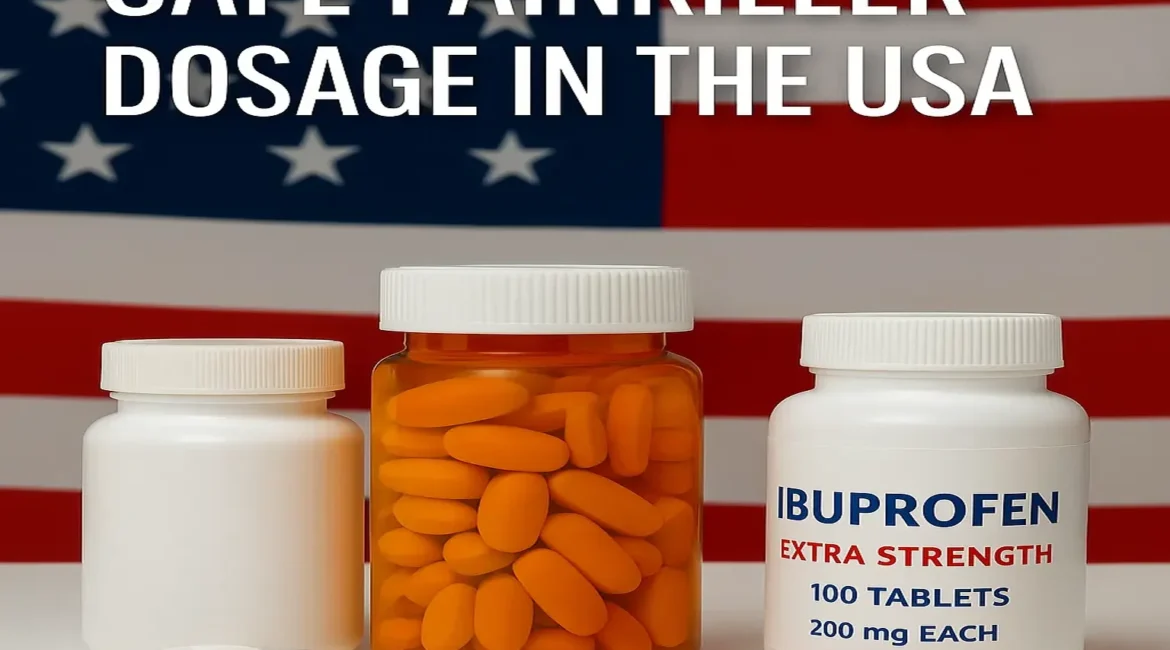Safe painkiller dosage in the USA
Safe pain killer dosage in the USA is essential to avoid serious health risks like liver damage or addiction. Understanding proper dosing can protect your well-being, especially when using common medications like acetaminophen, ibuprofen, or opioids. This guide helps Americans take painkillers responsibly and avoid dangerous mistakes in everyday use.
Are You Taking Too Much? Safe Dosage Tips for Common Painkillers
Pain is personal. Whether it’s a dull ache after a long day or the sharp sting of recovery, most of us reach for painkillers without thinking twice. In homes across the U.S., medications like acetaminophen, ibuprofen, and even prescription opioids sit within arm’s reach. But how safe is your dosage? Are you unknowingly crossing the line between relief and risk?
This guide offers a reality check—and equips you with the facts you need to protect yourself and your loved ones from avoidable harm.
Why Safe Dosing Matters in Everyday Life
Americans take billions of doses of painkillers each year. Most are over-the-counter, bought without a prescription, and taken at the first sign of discomfort. That’s not necessarily a bad thing—these medicines help people work, sleep, and recover. But what often goes overlooked is the fine line between therapeutic and toxic.
Even a “safe” drug like acetaminophen can cause liver damage if taken in excess. Ibuprofen and naproxen, though great for inflammation, can lead to bleeding, kidney problems, and heart concerns. Prescription opioids, meanwhile, come with serious risks—including dependence, overdose, and even death if not used exactly as directed.
The truth is that many people exceed safe doses without even realizing it. Mixing medications, misreading labels, or doubling up in a moment of pain are all too common. The good news? You can change that with a little knowledge and a commitment to dosing safely.
A Closer Look at Popular Painkillers
Here’s a breakdown of some of the most commonly used pain relievers in the United States:
- Acetaminophen (Tylenol): Often used for fever, headaches, or general pain. Found in many combination cold and flu products.
- Ibuprofen (Advil, Motrin): Great for inflammation, arthritis, and menstrual pain.
- Naproxen (Aleve): Longer-lasting anti-inflammatory often chosen for chronic pain.
- Aspirin (Bayer): An older pain reliever, sometimes used for heart health under medical guidance.
- Prescription opioids (Hydrocodone, Oxycodone, Morphine): Strong medications reserved for severe pain like post-surgery recovery.
Each has its own dosage guidelines—and potential dangers if misused.
What Could Go Wrong? Hidden Risks You Shouldn’t Ignore
Let’s be real: taking “just one more pill” seems harmless. But for many, that extra dose is enough to trigger serious consequences.
- Acetaminophen overdose is one of the leading causes of acute liver failure in the U.S. It’s especially risky because symptoms often don’t appear until damage is done.
- Ibuprofen and naproxen, both NSAIDs, are known to irritate the stomach lining, increase bleeding risk, and strain the kidneys with regular overuse.
- Opioids, even when prescribed, require exact dosing. Tolerance can build quickly, and dependence can sneak up silently.
Never assume that just because it’s sold over the counter, it’s risk-free.
How Much Is Too Much? A Simple Dosing Guide
Sticking to safe dosage limits is easier when you know the numbers. Here’s a reference chart for adults:
- Acetaminophen: Max 4000 mg/day
- Ibuprofen: Max 3200 mg/day
- Naproxen: Max 1250 mg/day
- Aspirin: Max 4000 mg/day
- Opioids: Only as prescribed—no universal max
For example, Extra Strength Tylenol contains 500 mg of acetaminophen per tablet. Taking more than eight tablets in 24 hours crosses the danger zone. The same logic applies to ibuprofen—watch the mg count and stay within the daily limit.
Also, be cautious with combination meds. Cold and flu remedies often sneak in extra acetaminophen or NSAIDs, pushing your intake beyond safe bounds.
Positive Steps Toward Safer Pain Relief
Here’s how you can take control:
- Use a medication tracker app—it’s simple and prevents double dosing.
- Keep a list of all medications you take, including supplements. Some may interact in unexpected ways.
- Read the label every time, even if it’s a brand you trust. Dosing may differ between versions.
- Store medicines out of reach of children, and never share prescription painkillers.
- Ask your doctor or pharmacist before mixing medications. It’s better to check than to guess.
Know When to Ask for Help
Pain that lingers or worsens may point to a deeper issue. If you’ve been self-treating for several days without relief, it’s time to check in with a professional.
Doctors can offer alternatives, explore underlying causes, and help manage pain without relying solely on medications. They may also recommend therapies like physical rehabilitation, mindfulness, dietary changes, or assistive devices—all of which can support long-term pain control.
Is Your Medicine Cabinet Helping or Hurting?
Take stock of what’s inside:
- Are your meds expired? Toss them out.
- Are you storing opioids you no longer need? Dispose of them safely at a community take-back site.
- Do you have duplicate products with overlapping ingredients? This increases the risk of accidental overdose.
Set aside time every few months for a medicine cabinet audit. It’s a small task with big impact.
Conclusion: Relief Shouldn’t Come with Regret
Painkillers are powerful tools. Used wisely, they can improve your quality of life and restore normalcy when you need it most. But misuse—whether accidental or intentional—can undermine your health in ways you may not see until it’s too late.
Being informed isn’t about paranoia. It’s about taking ownership of your choices and making smarter ones for your body and your future.
Published by DrugKart.net—committed to empowering Americans with trustworthy, evidence-based guidance for better health decisions.

